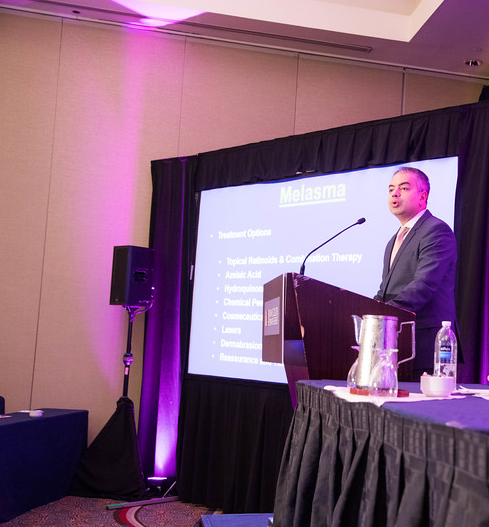During his talk at the 2018 Skin of Color Seminar Series (now known as the Skin of Color Update), Dr. Seemal Desai discussed the treatment of melasma with a particular emphasis on new and emerging therapies. Dr. Bridget Kaufman, onsite correspondent for the meeting, shares highlights directly from the talk. *Clinical pearls* from this session are bolded, underlined, and marked with asterisks.
Dr. Desai started by stressing the importance of having an honest and upfront conversation with your melasma patients about realistic expectations for treatment. *You must emphasize to patients that this is a chronic condition and set their expectations accordingly.*While improvement with treatment is likely, there will always be underlying pigmentary changes even despite treatment. Patients must understand from the beginning that they cannot be cured of this condition.
Dr. Desai then addressed the large vasodilatation/vascular component of melasma. Although the predominant feature of melasma is the hyperpigmented patch, a pink hue becomes apparent after treatment of the brown pigment. Historically, the redness was thought to be a side effect of Modified Kligman’s Formula, but more recent research suggests that this due to an inherent expression of vascular markers in melasma lesions. This vascular component can be treated with low fluence pulsed dye laser; oral tranexamic acid has also been helpful in Dr. Desai’s practice.
Dr. Desai then addressed the relationship between thyroid disease and melasma. There are a few studies showing thyroid disease in patients with recalcitrant melasma. *If, after optimal treatment, a patient does not improve within 3-6 months, you may want to get a free T4 and TSH to screen for thyroid disease.*
So now onto the treatment of melasma! Given that triple combination cream (TCC) is the gold standard therapy for melasma, it makes sense that Dr. Desai started with a discussion of research on this product. A randomized controlled trial of TCC in Southeast and East Asian patients with melasma found that, after 8 weeks of treatment, *TCC was superior to monotherapy with hydroquinone, although it was associated with more adverse effects.* Dr. Desai has found this to be true in his practice and, therefore, he rarely prescribes hydroquinone alone. The retinoid and steroid in TCC help with desquamation and exhibit anti-inflammatory properties that counter the upregulation of prostaglandins and tyrosinase in melasma.
Dr. Desai believes that hydroquinone is safe when prescribed by dermatologists in a controlled fashion, but he always discusses the risks of long term use with his patients.*None of his patients leave the office with a refill for a hydroquinone-based product* so that he can closely monitor their progress and ensure that they don’t run rampant with the prescription. Further, *Dr. Desai suggests a rotational algorithm that includes alternating use of TCC (for 8 weeks) and non-hydroquinone topical product(s)* to help prevent exogenous ochronosis. For the “off-rotation” topical, Dr. Desai’s go to is azelaic acid, which is available in 15% and 20% concentrations. A study in India using 20% azelaic acid twice daily demonstrated improvement in 73% of patients after 6 months of therapy. *Azelaic acid is safe for long-term use, has minimal side effects (most commonly burning and tingling), and can be used during pregnancy.*
Next, Dr. Desai discussed newer global therapies that show promise for the treatment of melasma. Kojic acid dipalmitate (different molecular ingredient than kojic acid) is a tyrosine inhibitor being used in botanical-based skin care products in India, UK, Saudi Arabia, Japan, etc. It is much more UV- and light-stable than traditional kojic acid, which helps enhance UV protection. A study of kojic acid dipalmitate 0.75% monotherapy in India demonstrated significant improvement in melasma severity at 8 weeks, which was maintained until 12 weeks.
Methimazole is a medication taken orally for the treatment of hyperthyroidism and thyrotoxicosis. As a potent peroxidase inhibitor, methimazole blocks a key step in melanogenesis (final packaging steps of melanosomes), which leads to a morphological change in melanocytes. Methimazole has been compounded into a cream base that is odorless, well-tolerated, and non-melanotoxic even at high concentrations.
A number of oral anti-oxidants are also available, including green tea extracts, Procyanidin, oral zinc supplementation, and polypodium leucotomos. Polypodium leucotomos, which increases the body’s natural SPF and acts as an antioxidant, has been associated with an improvement in melasma at 240mg taken 3 times daily for 12 weeks. Given the logistical difficulties with TID dosing, *Dr. Desai recommends that patients with melasma take polypodium leucotomos twice daily.*
Lastly, tranexamic acid (TXA) is a fibrinolytic agent that is gaining popularity for its use as an oral and topical treatment for melasma. TXA inhibits plasminogen activator, which decreases production of arachidonic acid, decreases prostaglandin levels, and ultimately inhibits tyrosinase activity leading to reduced cutaneous pigment. *Prior to starting TXA, you must take a good history and document that the patient lacks all contraindications to this treatment.*Contraindications include current/past DVT, PE, clotting disorder, anti-coagulant medications, pregnancy, breastfeeding, smoking, and renal/cardiac/pulmonary diseases. *The most effective dose of oral TXA seems to be 500mg, and it is typically dosed at 250mg to 500mg BID.*
In the United States, the only available form of TXA is brand name Lysteda® 650mg, which is FDA approved for the treatment of cyclic heavy menstrual bleeding. *Dr. Desai tells his patients to cut Lysteda® in half; take half (325mg) in morning and half (325mg) in the evening.*Typically you will see improvement within 8-12 weeks. *If you do not see improvement in 8-12 weeks, then you probably won’t see any effect with TXA.*Dr. Desai will continue TXA as long as patients are improving, but often he tapers down to once daily as maintenance therapy. At this point, there does not appear to be a limit to how long a patient should remain on TXA, although none of his patients have been on it for more than 7 months.
Dr. Desai’s final point was that patients often cannot differentiate between “lightness” of the skin and “brightness/tone.” Typically, patients who say they want to be “lighter” will be happy when you improve their texture and tone. If you want to learn more about skin lightening and how to approach patients who are interested in skin lightening, check out my coverage of the panel discussion “The Skin Lightening Dilemma: A Candid Conversation with the Experts,” which includes the viewpoints of Dr. Desai, Dr. Valerie Callender, and Dr. Eliot Battle.


